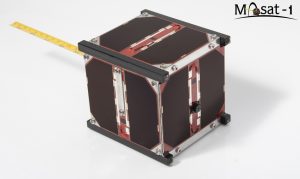Attention, expertise
and security
Attention, expertise
and security

Masat-1, the First Hungarian Small Satellite
The creation of the first Hungarian small satellite was enabled by the unprecedented support
and collaboration of developers from two departments of the Faculty of Electrical Engineering
and Informatics of the Budapest University of Technology and Economics (BME), the
Department of Electron Devices and the Department of Broadband Infocommunications and
Electromagnetic Theory, the Hungarian Space Office and more than 60 domestic and foreign
companies.
Based on the CubeSat standard, Masat-1 is a cubical object having edges of 10 cm
and a mass of less than 1 kg. It was launched in 13 February 2021 by the Vega launcher of
the European Space Agency (ESA) into an orbit with an apogee of 1450 km and a perigee of
300 km. As the 72an operation radio amateur satellite in the world, Masat-1 was designated
as MO-72. The satellite has broken almost all world records within its category. Since 8
March 2012 it has created hundreds of splendid 2D and 3D photographs and space mosaics
featuring our Earth with the 640×480 pixels of its on-board camera.
Communicating in the radio band of 437 MHZ during its mission, Masat-1 can transmit data
packets with data rates of 625, 1250 and 5000 bit/s. These packets contain the values of
physical quantities measured continuously in hundreds of telemetry channels and the
contents of about 100 internal variables, available on request by specific commands. Almost
half of the received data was captures by the primary and secondary ground control stations,
the rest being provided by radio amateurs from all around the world. The primary control
station, which also operates as a demonstrational station, is located at the top of Building E
of BME, the secondary control station is located at Érd; they both provide fully automatic and
remote controllable operation.
The success of Masat-1 demonstrates the high level of engineering education at BME, which
provides an appropriate, solid foundation for the continuation of the Masat programme and
also for intensifying space-related scientific experiments, research and industrial applications
in Hungary.
